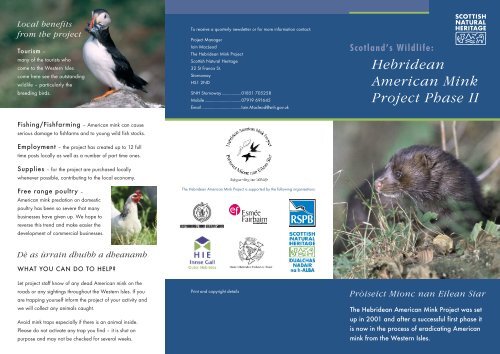Scotland's Wildlife
Scotland's Wildlife
Scotland's Wildlife
Create successful ePaper yourself
Turn your PDF publications into a flip-book with our unique Google optimized e-Paper software.
Local benefits<br />
from the project<br />
Tourism –<br />
many of the tourists who<br />
come to the Western Isles<br />
come here see the outstanding<br />
wildlife – particularly the<br />
breeding birds.<br />
To receive a quarterly newsletter or for more information contact:<br />
Project Manager<br />
Iain MacLeod<br />
The Hebridean Mink Project<br />
Scottish Natural Heritage<br />
32 St Francis St.<br />
Stornoway<br />
HS1 2ND<br />
SNH Stornoway ..................01851 705258<br />
Mobile..................................07919 691645<br />
Email .....................................Iain.Macleod@snh.gov.uk<br />
Scotland’s <strong>Wildlife</strong>:<br />
Hebridean<br />
American Mink<br />
Project Phase II<br />
Fishing/Fishfarming – American mink can cause<br />
serious damage to fishfarms and to young wild fish stocks.<br />
Employment – the project has created up to 12 full<br />
time posts locally as well as a number of part time ones.<br />
Supplies – for the project are purchased locally<br />
whenever possible, contributing to the local economy.<br />
Free range poultry –<br />
American mink predation on domestic<br />
poultry has been so severe that many<br />
businesses have given up. We hope to<br />
reverse this trend and make easier the<br />
development of commercial businesses.<br />
The Hebridean American Mink Project is supported by the following organisations:<br />
Dè as ùrrain dhuibh a dheanamh<br />
WHAT YOU CAN DO TO HELP?<br />
Let project staff know of any dead American mink on the<br />
roads or any sightings throughout the Western Isles. If you<br />
are trapping yourself inform the project of your activity and<br />
we will collect any animals caught.<br />
Avoid mink traps especially if there is an animal inside.<br />
Please do not activate any trap you find – it is shut on<br />
purpose and may not be checked for several weeks.<br />
Print and copyright details<br />
Pròiseict Mionc nan Eilean Siar<br />
The Hebridean American Mink Project was set<br />
up in 2001 and after a successful first phase it<br />
is now in the process of eradicating American<br />
mink from the Western Isles.
Am Mionc Aimearaganach<br />
The American mink (Mustela vison) is a semi-aquatic carnivore<br />
that first became established in the wild in Britain in the 1950s<br />
following numerous escapes and releases from fur farms. It has<br />
now spread throughout most of the country.<br />
American mink were brought to the Western Isles by fur farming<br />
in the 50s and 60s, with feral individuals first recorded in Lewis<br />
in 1969. They have since spread southwards, reaching South Uist<br />
by 2001.<br />
This invasive non-native species is a proficient hunter and its varied<br />
diet consists largely of birds, small mammals, fish and crabs. Some<br />
birds are particularly vulnerable to mink predation as they nest on<br />
the ground in large colonies.<br />
After a spring mating females give birth to between three and<br />
seven kits in June. The surviving kits are independent and start<br />
dispersing from mid-July. American mink can live for up to 8<br />
years but 50% of youngsters die in their first year.<br />
MANAGEMENT OF THE PROJECT<br />
The project is managed by SNH with a project advisory group<br />
meeting quarterly made up of the principal partners.<br />
Sgire glacaidh<br />
TRAPPING AREA IN PHASE II<br />
The trapping programme<br />
will concentrate on<br />
the area of Lewis<br />
and Harris.<br />
Starting in South<br />
Harris and<br />
creating a<br />
widening<br />
buffer zone<br />
as the project<br />
progresses.<br />
with.<br />
In the Uists a<br />
monitoring<br />
presence shall<br />
be maintained<br />
so that any small<br />
populations of<br />
American mink that<br />
may become reestablished<br />
can be dealt<br />
It is expected to have about 7500<br />
traps placed in Lewis and Harris<br />
operated on a rotational basis.<br />
This suggests that things will be left for a very<br />
Amasan na pròiseict<br />
AIMS OF THE PROJECT<br />
To eradicate American mink from the Western Isles<br />
archipelago.<br />
To protect many species of ground nesting birds and the<br />
indigenous freshwater fish stocks of the islands.<br />
To raise awareness of wildlife conservation and the issue<br />
of non-native predator control.<br />
Dòighean glacaidh<br />
TRAPPING METHODS<br />
There is a team of trappers, supervised by a foreman, who<br />
work in the Lewis and Harris area. In addition a smaller<br />
team is employed on a part time basis to monitor the Uists<br />
and ensure that any American mink sightings are investigated.<br />
Modern GPS units and GIS technologies are used extensively<br />
throughout the project to structure the trapping and locate<br />
traps.<br />
Mink traps are<br />
dug into the<br />
ground and<br />
covered with<br />
turf to resemble<br />
a tunnel. Traps<br />
are left in<br />
place for the lifetime of the project and opened on<br />
a rotational basis. When open all traps are checked daily.<br />
Beachdan a’ choimhearsnachd<br />
COMMUNITY INVOLVEMENT<br />
A Community Liason Forum is being established to provide<br />
an opportunity for local people, landowners and<br />
organisations to be involved with the project.<br />
Rannsachadh<br />
RESEARCH<br />
The data from Phase I were used to create a population<br />
model to estimate the resources required for Phase II.<br />
All new data will be collated and the model extended to<br />
ensure that the current trapping strategy is reducing the<br />
American mink population fast enough to achieve<br />
eradication within the project lifespan.<br />
The RSPB are continuing with the monitoring of breeding<br />
bird colonies within the control area.

















